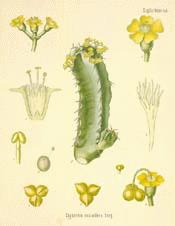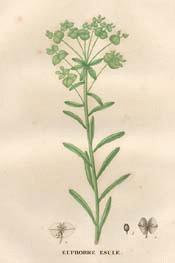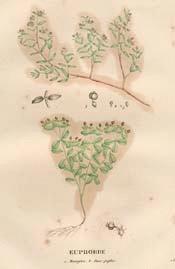
SpurgesPOISON!Botanical: Euphorbias
Genera more than 200, species more than 3,000, representing almost all habits of growth and exhibiting a high degree of adaptability to varying environments. The valuable rubbers produced by the family are of great importance, notably that from the prepared milk juice of several species of Hevea, known in commerce as Para rubber.
|

|
(Euphorbia resinifera erg & C.F. Schmidt) |
Botanical: Euphorbia resinifera
Family: N.O. Euphorbiaceae
---Synonyms---Euphorbia officinarum. Poisonous Gum-Thistle. Dergmuse. Darkmous. Euphorbium Bush. Gun Euphorbium.
---Part Used---Concrete resinous juice.
---Habitat---The slopes of the Great Atlas range in Morocco.
---Description---Resembling a cactus in appearance, this leafless perennial plant has a stem about 4 feet in height, and many branches. The flowers are small, simple, and bright yellow, and the fruit a small capsule with one seed in each cell. Specimens sent to Kew in 1870 have never flowered, but others have done so in Paris. Both Pliny and Dioscorides knew the drug, and its name is classical.
The milky juice is collected from incisions made in the fleshy branches, and is so acrid that it burns the fingers. It flows down the stems and encrusts them as it hardens in the sun. Poor Arabs bring in the resinous masses for sale in Morocco, whence it is chiefly exported from Mogador. The dust is so intensely irritant to the mucous membrane that the mouth and nose of those handling it must be covered by a cloth.
In commerce the drug is found in yellowish-brown 'tears' that have a waxy appearance. They are almost transparent, slightly aromatic only when heated, and often pierced with holes made by the prickles of the plant while drying. The taste is slight, but becomes very acrid.
It is said to be employed as an ingredient of paint used for preserving ships' bottoms.
At Mogador, the branches are used for tanning leather.
[Top] [Top of Spurge, Officinal]
---Constituents---The chief constituent is resin, and it also contains wax, calcium malate, potassium malate, lignin, bassorin, volatile oil, and water, with no soluble gum. Another analysis gives euphorbone, euphorbo-resene, euphorbic acid, calcium malate, a very acrid substance not yet isolated, and vegetable debris.
The acrid resin is soluble in alcohol, and will burn brilliantly, becoming very aromatic.
The powder is yellowish, and violently sternatatory.
---Medicinal Action and Uses---The internal use of the drug has been abandoned, owing to the severity of its action. It is an irritant emetic and cathartic. Its chief use is as a vesicant, and principally in veterinary practice. It has been used in dropsy; mixed with cantharides as a 'gout plaister'; and as an errhine in chronic brain, ear, or eye complaints, sometimes mitigated with the powder of Convallaria maialis, but accidents have led to its use being discontinued.
[Top] [Top of Spurge, Officinal]
SPURGES, VARIOUS

|
'PILLBEARING SPURGE' (E. pilulifera) is commonly known as Queensland asthma weed, cat's hair, in allusion to its globular, axillary inflorescences. Is very common in all tropical countries. Its principal constituents are resins described as glucosidal, wax, and volatile matter; it is collected whilst flowering and fruiting, and has been utilized by some practitioners with a certain success in the treatment of subacute and chronic inflammation of the respiratory duct. Toxic doses have killed small animals through failure of respiration. The decoction is taken in asthmatic conditions, chronic bronchitis, and emphysema, the tincture being used in coryza and hay fever.
---Dosage---Compound Elixir of Euphorbia, C.F., from E. pilulifera. Tincture of Euphorbia, B.P.C., from E. pilulifera, 10 to 30 minims. Fluid extract of E. pilulifera, 1/2 to 1 drachm. Decoction of E. pilulifera, 1 in 40, 1 tablespoonful.
E. corollata: dose of dried root as an emetic, 10 to 20 grains; as a cathartic, 3 to 10 grains.
E. hypericifolia: an infusion of the dried leaves, 1/2 OZ. infused in a pint of boiling water for 1/2 hour and a tablespoonful taken for a dose.
[Top] [Top of Spruges, Various]
---Other Species---
E. tetragona, E. antiguorum of the African coast, and E. canariensis of the Canary Islands also supply the drug.
WHITE IPECACUANHA (E. ipecacuanha), the root of which is used, contains a fixed oil, starch, glucose, and various salts, also resin. Its medicinal properties are similar to E. corollata.
WHITE PURSLANE (E. corollata). Syn. White Parsley, Purging or Emetic Root, Apple Root, Wild Hippo. The whole plant is used, including the root. Its habitat is east and central North America. It abounds in lactiferous ducts, which contain starch; the resin is or carries the actual principle, the presence of glucoside is conjecture. Formerly it was used as an emetic in 10 to 20 grains, and as a cathartic in 3 to 10 grains, but because of its irritating and uncertain properties its use has been practically abandoned; the recent root bruised and applied to the skin produces vesication.
CAPER SPURGE (E. lathyris). (Syn. Mole Plant.) Has a milky juice of an acrid nature. Its seeds yield an abundance of fine clear oil called oil of Euphorbia; this is obtained by expression or by the action of alcohol or ether, and is colourless, inodorous, and almost insipid; it rapidly becomes rancid, and acquires a dangerous acrimony. The oil is a very violent poison, producing violent purgation and having an irritating effect upon the mucous membrane of the intestinal canal, and especially on the larger intestines; the oil resembles croton oil. In doses of 5 drops it is said to be less acrid and irritating than croton oil; it must be recently extracted. The seeds to the number of twelve or fifteen are used by country people in France as a purgative. The root of the plant is equally purgative and emetic; the leaves are vesicant and are used by beggars to produce ulcers by which to excite pity; the juice is depilatory; the seeds contain aesculetin in the free state.
E. hypericifolia is regarded in tropical America as a powerful astringent and has a reputation in the cure of diarrhoea and dysentery; it has also narcotic properties. The juice is said to cause temporary blindness when applied to the eyes; it contains caoutchouc, gallic acid, resin and tannin.
SPOTTED SPURGE (E. maculata) represents a group used by eclectics and homoeopaths with claims for properties more or less special. It has been used in cholera, diarrhcea and dysentery in the form of an infusion of the leaves, and has been found to contain caoutchouc resin, tannin, and apparently euphorbon. Is said to be a valuable astringent; an infusion may be employed as an injection in the treatment of leucorrhoea. To this medicinal group belongs:
E. esula (Linn.) (Leafy Spurge) of Europe.
E. peplus (Linn.) of Europe.
E. helioscopia (Linn.) of Europe (Sun or Wart Spurge, Churnstaff, Seven Sisters).
E. humistrata (Engl.) of central North America.
E. hypericifolia (Linn.) of North America.
E. portulacoides of Chile.
E. iata (Eng.) of U.S.A.
E. marginata (Pursh.) (Mountain Snow) of western U.S.A.
E. Drummondii, the juice, has caused many fatalities to sheep and cattle in Australia.
E. cremocarpus is used in Australia for the poisoning of fish in calm pools and streams.
E. heterodoxa, a Brazilian species, said to have been used with extraordinary success against cancerous and syphilitic ulcers. It is a powerful irritant, mildly caustic; the milky juice preserved with salicylic acid is used.
E. prostata grows in the south-western portions of the U.S.A., and has the reputation of being a specific against the bite of the rattlesnake, spiders, etc.; the juice is used.
E. parviflora and E. hirta. Both used in India as antisyphilitics, and E. canescens similarly in Spain.
The juice of E. linearis is employed in Brazil for syphilitic ulcers of the cornua. E. hiberna was formerly much used in syphilis before the introduction of mercury. The plant is extensively employed by the peasantry of Kerry for stupefying fish, and so powerful are its qualities that a small basket filled with the bruised leaves will poison the fish for several miles down the river. The same properties are possessed by E. platyphylla, and in Brazil E. cotinifolia is used for the same purpose, and the acrid juice which drops from it is used by the natives to poison their arrows.
The seeds and leaves of E. thymifolia of India are given by the Tamuls as an anthelmintic and in bowel affections of children.
E. balsamifera, when cooked, is eaten in the Canaries.
The juice of E. Mauritanica, when dried, is employed as a condiment, and forms one of the adulterations of Scammony.

|
In countries bordering on the Mediterranean, E. Peplis, E. spinosa, E. Dendroides, E. Aleppica, E. Apois, are used as purgatives in domestic practice.
E. peplus, E. peploides, E. pilosa, E. palustris have the reputation of being remedies in hydrophobia.
E. Helisscopia juice is commonly applied to warts, and sometimes, though improperly, used to cure sore eyelids, causing in many instances intolerable pain and inflammation.
The bark of the roots of E. Gerardiane, E. amydaloides and E. Cyparissias have febrifuge reputations; but the latter is known to possess dangerous properties. It is destructive to sheep, and La Motte has seen a woman perish from having taken a lavement prepared with the plant. In France it is used as a popular purgative, under the name of Rhubarbe??des pauvres. Orfila regards it as a poison.
The milky juice of E. amydaloides is very acrid, and though not highly poisonous, corrodes and ulcerates the flesh wherever it is applied.
Warts and corns anointed with it are said soon to disappear, but great caution is needed in using it, or injury is likely to result to the surrounding skin. Though said to be a remedy for toothache, it is not to be recommended on account of its very acrid nature.
The juice of E. tribuloides, a small cactusshaped species growing in the Canaries, is there used as a diaphoretic.
It is reported by Scopoli, in his Flora Carnoilica, that he has seen death occasioned by the administration of 30 grains of the seed of E. esula, and gangrene caused on the belly by the application of the plant on that part; he also adds that people have lost their eyesight by rubbing their eyes with its juice.
E. buxifolia in the West Indies, E. papillosa in Brazil, E. laurifolia in Peru, and E. portulacoides in Chile are used as purgatives.
E. tirucalli is employed in India as a vesicant, and in Java as a powerful emetic and purgative. It is said that exhalations from the tree cause the loss of eyesight; the juice is considered sudorific and, according to Sonnerat, is administered in India, in doses of a drachm, mixed with flour, daily as an antisyphilitic.
E. ligularia, another native of India, is held sacred to Munsa, the goddess of serpents; the root of the tree, mixed with black pepper, is employed for the cure of snake-bites, both internally and externally.
[Top]
© Copyright Protected 1995-2004 botanical.com
